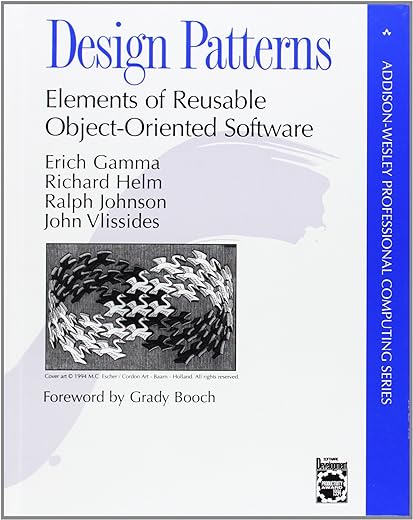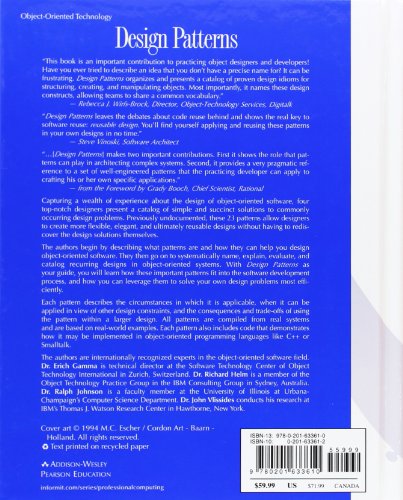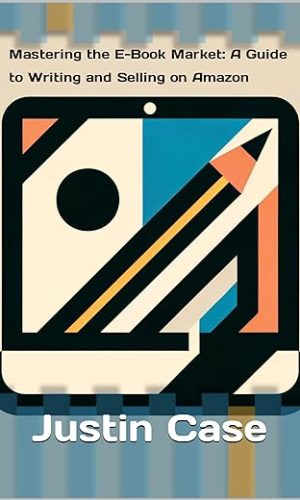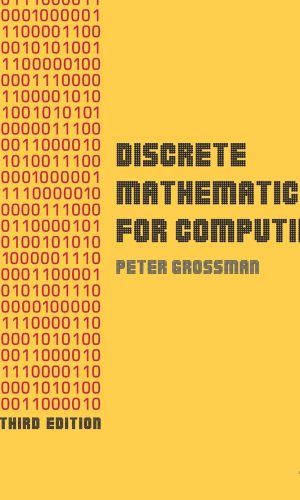Design patterns : elements of reusable object-oriented software
£38.40£42.30 (-9%)
The authors begin by describing what patterns are and how they can help you design object-oriented software. They then go on to systematically name, explain, evaluate, and catalog recurring designs in object-oriented systems. With Design Patterns as your guide, you will learn how these important patterns fit into the software development process, and how you can leverage them to solve your own design problems most efficiently.
Each pattern describes the circumstances in which it is applicable, when it can be applied in view of other design constraints, and the consequences and trade-offs of using the pattern within a larger design. All patterns are compiled from real systems and are based on real-world examples. Each pattern also includes code that demonstrates how it may be implemented in object-oriented programming languages like C++ or Smalltalk.
Read more
Additional information
| Publisher | 1st edition (14 Mar. 1995), Addison-Wesley |
|---|---|
| Language | English |
| Hardcover | 416 pages |
| ISBN-10 | 0201633612 |
| ISBN-13 | 978-0201633610 |
| Dimensions | 23.65 x 19.35 x 2.64 cm |











by Kindle Customer
Easy to pick up and perfect as a reference guide. Using these patterns in your work will make it easier for yourself and others to get up to speed when you come back to it later
by Thanh Nguyen
The Gang of Four is already well-known in Software Industry, with many of the patterns introduced in this book are very popular in real world projects. But that’s not the main point of why you need to read this. The way the four authors distilled their experience, explained the abstract knowledge, demonstrated the use cases and categorised the patterns are classic! Reading this book is not only lot of fun, but also really enlighted in terms of deeply understanding why you could do better in the past and how you actually do better in the future. Last but not least, this is far beyond a one-time book, it’ll be your patterns dictionary in the future.
by Jabble
Almost 30 years on, this is still the baseline book for design patterns. The descriptions are comprehensive and the examples help clarify what is intended, albeit using C++ as it was written in the ’90s. There should be no problem implementing the ideas in a modern incarnation (indeed the STL encompasses some ideas), or in other OOP languages for that matter.
by Dan
Content of the book so far is great, the quality of the book however is terrible. The spine has been too tightly bound and as a result entire sections have fallen out from just being read.
The information is worth it so buy from better quality vendor.
by Sohnee
This book is the original and best. Yes, it is pretty dry – but you don’t read it like a novel. Simply scan through the various patterns so you know that they exist, then when the need comes up and you think “I’m sure there is a pattern that could be adapted to solve this problem” – you go back and read in depth to refresh your memory.
Every team who use object-orientation should have a copy in the office to refer to.
If you want a softer read, there is a Head First book on design patterns – but I would still recommend having a copy of this book to refer to when you want to implement and adapt a pattern in real life.
by NAME_NOT_RETURNED
I would recommend this book to everyone who wants to further their knowledge about general OOP design patterns. This book is a well-known classic, not without a reason. I believe other reviewers already described why this is a must-read for any senior OOP developer. However, there is also a few things I didn’t like about this book.
– Programming languages. I do vast majority of my coding in Java, sometimes I code in another JVM languages. This book provides examples in C++ and/or Smalltalk. Even more, this book was written before Java was a thing! This has to have an impact on how easy to follow are some of the examples. If you write Java 8 code, I bet you know what is the difference between external and internal iterator. At the same time, C++ friends will probably be less obvious to you, and the concept of e.g. enum-based singletons will not be mentioned at all. If only someone could write this book once again, but focus on Java-centric point of view.
– GUI-based examples. For nearly all the patterns, there is a GUI-related example. I am deeply alergic to GUI development and would appreciate more examples relating to backend functionalities.
– Didn’t we evolve since then? Many of these design patterns are explicitly targetting challenges around excessive memory utilisation and other past limitations. We can do better now. Same constraints still exist, but are applicable to a very different extent. I can see people blindly following some of these patterns today in the field, with very little reflection upon the actual problem they are trying to solve. Today good programming is frequently not about making the application consume less memory, but about making it easier to understand and change. The problems we are trying to solve have changed, therefore the solutions we apply need to change as well. Keep it in mind while reading this book – not all of that is of equal value today, as it was when this book was first published. This takes us swiftly to the next point, which is…
– The pattern catalogue. While many of these design patterns are still valuable these days, there may be others which are more valuable. Just compare and contrast the builder pattern, as described in this book vs the one described many years later by Joshua Bloch.
My recommendation – read this book if you haven’t done it already. Learn all the good things, just don’t forget the world has moved on since then.
by Some guy from Sheffield
This book contains really useful information, and really can benefit you and your job, but it is also a tough read, requiring saintly perseverence (see comments on first half!) or deep concentration (see comments on second half!).
The first half of the book is a large example, which reminds me of the mind numbingly boring and irrelevant case studies presented to me at university… in fact, I got bored, and stopped reading it. Maybe there’s a twist at the end… I don’t know – I got bored.
The second half, on the other hand, contains fantastic descriptions of patterns, object model diagrams, and details on how and when to use them. These sections need your full attention, and you need to know something about OO design already, but if you’ve got all that it’s great.
And if you’re suffering from insomnia, you can always start reading the first half of the book…!
by Rado
The book is great and the delivery was swift without any delay and was even delivered earlier than expected. Thanks you!